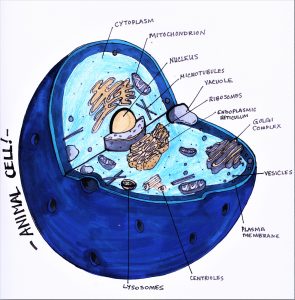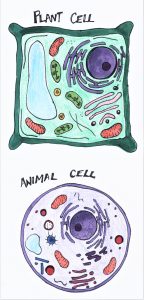
Author: Layal Bou Abdo MSN
Illustration: Angeline Boswell
Human Organs
An organ is a group of tissues that work together to perform a specific function. For the most part, organs are squishy and soft. There are seven vital organs in your body that you cannot live without The brain, the heart, two lungs, the liver and two kidneys.
Tissue is a group of cells of a particular kind that have a similar structure and function together as a unit.
There are four main tissue types in the body: epithelial, connective, muscle, and nervous. Each tissue is for specific functions.
- Epithelial tissue exists in glands in the kidney tubules, stomach and intestines, portions of the respiratory tract, and some of the tubes of the male reproductive tract. Epithelial tissues form the covering of all body surfaces, line body cavities and hollow organs.
- Connective tissue is in the blood, cartilage and bone. Connective tissues form support for organs, store fat, transport substances, protect against disease, and help repair tissue damage.
- Muscle tissue cells can shorten or contract to move the body parts. There are three kinds:
- Skeletal voluntary muscles that you use to move around. They cover the bones and that you can control.
- Smooth involuntary muscles exist inside your digestive tract.
- Cardiac involuntary muscles that make up your heart
- Nervous tissue constitutes the brain, spinal cord, and nerves. It is responsible for coordinating and controlling many body activities.
The cell is the basic unit of life. Cells are so small that you cannot see without a microscope. They exist in all living things (plants, animals, germs). Some organisms have a single cell, like bacteria, while others have trillions of cells, like the human body.
Let’s explore more about the cells!
Cells are like tiny water balloons; each one is a soft sac filled with liquid. These balloons combined, become solid and squishy – just like your body!
Do All Cells Look the Same?
Cells come in many shapes and sizes. Some cells hold a cell wall, while others have slimy coats or elongated structures that push and pull them through their environment. Some cells have a thick layer surrounding them. This layer is called the capsule and exists in bacteria.
Types of cells
All cells have three things in common, no matter what type they are:
- A membrane separating the inside of the cell from its environment.
- The cytoplasm is a jelly-like fluid.
- DNA or the cell genetic materials.
Cells types are two types: prokaryotic and eukaryotic:
- The Eukaryotic cell has organelles which include the nucleus, enclosing the DNA, and other special parts. Eukaryotic cells are complex; they make plants and animals. Eukaryotic cells are also called multicellular.
- The Prokaryotic cell does not have a nucleus or membrane-enclosed organelles. Prokaryotic cells are simple. They have genetic materials but not within the nucleus. Prokaryotic cells are also called unicellular organisms such as bacteria.
Parts of the cell
Several Organelles or “little organs” make up the cells. They are the specialized part of the cell that has a unique job to perform.
Nucleus: The nucleus controls center of the cell. It contains the genetic materials (DNA) of the cell. It dictates what the cell is doing today and how it is going to do it.
DNA(Deoxyribonucleic Acid): The DNA contains all the information for cells to live, perform their functions and reproduce.
Chromatin: chromatin is a tangled spread out of the DNA. It is found inside the nuclear membrane when a cell is ready to divide its DNA into structures known as chromosomes.
Nucleolus: Inside the nucleus exists the nucleolus. The nucleolus makes ribosomes. After the ribosomes leave the nucleus, they will make proteins. The circles on the surface of the nucleus are the nuclear pores. These are where ribosomes and other materials move in and out of the nucleus.
Cytoplasm: All organelles inside the cell float in the cytoplasm. The ribosomes may wander freely within the cytoplasm or, they may attach to the endoplasmic reticulum.
Endoplasmic Reticulum: Also known as the ER, this membrane transports materials throughout the cell. Rough ER contains ribosomes to make proteins while, smooth ER makes fats, also called lipids.
Vesicles (small vessels): This organelle helps store and transport products produced by the cell. The vesicles are the transport and delivery vehicles like our mail and Canada Post trucks. Some vesicles deliver materials, to parts of the cell (endocytosis), and others transport materials outside the cell (exocytosis).

Golgi Body or Complex or Apparatus: Golgi body receives those vesicles. As proteins move throughout the Golgi body, they transform into forms that the cell can use. The Golgi complex is responsible for sorting and correctly shipping the proteins produced in the ER. Just like our postal packages, which should have a correct shipping address, the ER-produced proteins are correctly sent to their respective address. If the Golgi complex makes a mistake in shipping the proteins to the correct address, certain functions in the cell may stop. The Golgi body does this by folding the proteins into usable shapes or adding other materials into them, such as lipids or carbohydrates. Lipids from the ER move to the Golgi body. Then, it delivers them to the plasma membrane.
Vacuoles: Vacuoles are sac-like structures that store different materials (like water).
Lysosomes: These cell organelles help the cell get rid of waste. Lysosomes take damaged or worn-out cell parts. They have enzymes that break down the cellular debris. They are the garbage collectors.
Mitochondria: Mitochondria make energy. Some scientists call these organelles the powerhouses of the cell. During the cellular respiration process, the mitochondria make ATP molecules that provide the energy for all the cell’s activities. Cells that need more energy have more mitochondria, for example- your leg muscle cells, heart muscle cells
Cytoskeleton: the cell maintains its shape through them. The cytoskeleton includes microfilaments (thread-like proteins) and microtubules (thin hollow tubes).
Centrioles: Centrioles are paired barrel-shaped organelles located in the cytoplasm of animal cells near the nuclear envelope. They are made of microtubules. The centrioles are found in pairs and move towards the poles (opposite ends) of the nucleus when it is time for cell division. During division, you may also see groups of threads attached to the centrioles. Those threads are called the mitotic spindle. Centrioles cannot be seen when the cell is not dividing.
Both plant and animal cells have all the above organelles, but plant cells hold additional other parts.
Differences Between Plant and Animal Cells
 The most significant differences between plant and animal cell organelles are the cell wall, vacuoles and chloroplasts.
The most significant differences between plant and animal cell organelles are the cell wall, vacuoles and chloroplasts.
Plant cells have a rigid cell wall surrounding the plasma membrane. This wall gives the cells their rectangular structure and helps plants stand upright without the need for an internal reinforcing structure, such as bones.
Chloroplasts in plant cells generate energy through photosynthesis. The process takes sunlight and water and converts them into energy. Chloroplast is green in colour because of its green pigmentation; chlorophyll. Animal cells do not have chloroplasts.
Plant cells also have a single, large vacuole. As we explained above, vacuoles store different materials such as water and sap. The vacuole increases and decreases in size depending on the amount stored in them. When plants lack water, the vacuole shrinks, making the cell cave in on itself and causing the plant to droop. Unlike plant cells, animal cells have smaller vacuoles, that are more numerous and have different functions.
Animal cells, as well as microorganisms, also have exterior protrusions that help them to move:
- Cilia: The cilia look like tiny hairs outside of animal cells, and there are many of them.
- Flagella: The flagella is like a small tail that helps the cell move or propels forward. Some bacteria have flagella. The only human cells that have flagella are sperm cells.
Cells have either cilia or flagella.
Plant cells do not have cilia or flagella.
We found this interactive cell viewer and game that can be used to learn about the parts of cells.
Did you know?
- There are at least ten times as many bacteria in the human body as cells.
- In our body, there are many different kinds of cells. Our body constitutes about 200 different types of cells. The blood cells are distinct from the fat cells. Our body also has non-living materials such as hair, fingernails, and the hard part of teeth (enamel). Hence, dead cells or other minerals make up these materials.
- Adult bodies are about 50 to 65 percent water, while children’s bodies have a little more water at 75 percent. The human brain is about 75 percent water.
We are confident your kid asks you health (human & animal) questions that genuinely leave you stumped! Leave a comment below, and we are happy to answer “why” in future blogs. Reach out to us on Twitter using the #AskTheLittleMedicalSchool
Copyright © 2021 Little Medical School Ottawa

Informative article on body organs and tissues. I like the video on how the 6 year old extracts her own DNA.
Thank you so much for your feedback. We are happy that you liked it.
What are the implications of the squishiness of body organs for organ transplantation and regenerative medicine?
The softness of our organs is super important for organ transplants and making new body parts. When doctors match organs for a transplant, they need to find ones that feel the same. Scientists are also trying to create new body parts in a lab, and they want them to be soft like our real ones. The squishiness helps doctors do surgeries with tiny cuts, making it easier for people to get better faster. It also affects how medicines move inside our body. So, the squishiness of our organs is like a special power that helps doctors and scientists do amazing things to keep us healthy!